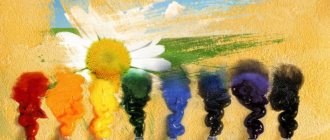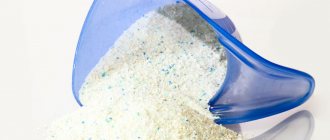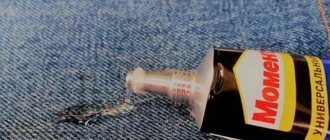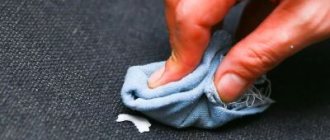Types of fabrics that can be dyed
Below are fabrics that can be dyed:
- Nylon can be painted with powder paint. The fabric absorbs the dye very quickly.
- Cotton, silk, linen, wool, wool mixture, these are the most suitable fabrics for dyeing. Absorbs paint easily and quickly, the color lasts for a long time.
- PVC fabrics are used for banners and street advertising. Acrylic dyes are used to color it.
Work process
Sweaters, jumpers and other warm items must not be dyed. The pigment will not be able to penetrate evenly into the fibers, which will simply ruin the product.
Natural cotton
General recommendations
Tips on how to dye clothes at home:
- if there are several products, they are painted one by one;
- wool product is diluted at high temperature;
- before dyeing flax and denim, the paint is mixed with a pinch of calcined salt, then dissolved with water;
- unevenly dyed viscose is placed briefly in a hot solution of washing powder - the color will become even;
- It is recommended to dye silk by adding a tablespoon of vinegar;
- the product that will be altered is ripped out before painting;
- to avoid burning, place a board at the bottom of the container;
- It is not difficult to dye a faded item; it absorbs the dye easily;
- Woolen clothes are dried flat out to prevent them from stretching.
Synthetic products should not be dyed yourself. Where to dye the fabric: you need to take the item to the dry cleaner. Professionals will do this evenly and correctly.
Useful
Interesting: you can mark a thing with ink, for example, when sending a child to camp. It will be impossible to iron the painted area and erase the mark.
Textile preparation
Before you start dyeing fabric at home, you need to prepare it.
You need to know about some painting rules before starting work:
- White fabrics can be dyed almost any color. And before dyeing bright things and fabrics, first bleach and remove the pigment;
- It must be remembered that the effectiveness of dyeing depends on the composition of the fabric. Best of all, the dye adheres to cotton material;
- Before starting work, be sure to wash the items for uniform coloring;
- To understand how much paint is needed, things are weighed and this parameter is determined;
- Painting things should be done in distilled water. Soften regular running water with baking soda.
Synthetic material
Preparatory operations
When using chemical dyes, be sure to read the instructions for them. Each manufacturer can make its own recommendations for the coloring process, but there are general requirements for both chemical and natural preparations. Items must be washed thoroughly, free of dirt and stains. If the dirt does not wash off, use a stain remover and then rinse the product well. Sometimes fruit and vegetable juices leave residue that cannot be removed. There is only one way out - paint the item in a color several tones darker than the stain. Boil starched linen in a solution of soap and soda, then rinse. Remove all decorative metal and plastic elements; they may lose their appearance when painted.
Sometimes things need to be altered after painting. In this case, all seams must be opened in advance so that they are evenly saturated with pigment. If you decide to dye a lined jacket or raincoat, be sure to open the bottom seam. Air bubbles collected between the lining and the base material will prevent the dye from being evenly distributed on the fabric.
Prepare all necessary equipment in advance. First of all, find a tank in which the fabric will be completely submerged in water and lie freely. It is advisable to take an enamel container. You can use a galvanized or aluminum vessel if you clean it well from scale. Prepare two smooth wooden sticks with which you will stir and turn the product over. Don't forget to buy rubber gloves, otherwise your hands will be painted the most fantastic color for several days and you will have to hide them from others.
Now you need to prepare the liquid. It is advisable to use soft melt or rain water. If you only have hard water, add a tablespoon of baking soda to the bucket of liquid. First dilute the powder dyes in a small container so that no grains remain. Strain the solution and pour into the paint tank.
Dyes for materials
The most popular fabric paints are acrylic and natural. They are the most affordable, and the results almost always last up to 20 washes. Such substances do not affect the human body because they do not contain ammonia or other toxins. For needlewomen, it is recommended to use powder dye. It is convenient to stir it and control the exact amount needed for the product.
You might be interested in Simple life-size Tilda hare patterns
Acrylic paints
These dyes are good because they require minimal preliminary preparation. Drawing on fabric is as easy as drawing on paper. But, it is advisable to understand that to apply a pattern to a thing you need to use a stencil.
Textile dye
This way the drawing will turn out clear and without blurring along the contour.
Important! Paints can be diluted with water, but not too much, otherwise all their properties will deteriorate.
Since acrylic paints dry quickly, the jar should not be left open for more than an hour. Otherwise, all its properties will be lost. If you need to trace the lines of the drawing carefully, it is recommended to buy a special outline for clothing.
Turmeric for yellow color
Aniline dyes
These are organic substances that are formed as a result of the oxidation of aniline. The main component, aniline, was derived from natural indigo. Scientists have been able to prove that bright colors can be made using it. Aniline dyes are partly used in production for dyeing things. At home, fabric dyeing with such paints is not done.
Natural dyes for fabrics
Natural dyes are taken from food, seasonings and other things. The most popular are turmeric (for the yellow color), barberry, buckwheat, blackberry, blueberry, etc.
Traditional methods
Many people use such paints because they are safe and do not cost too much. But painting with such means is a rather labor-intensive process. For green color, medicines such as brilliant green and potassium permanganate are used. Brown and dark colors could be obtained by mixing black coffee, onion skins and tea. For blue and gray colors, currants are usually used. The entire process of cooking the fabric will take about three hours. But the color will last longer than with any store-bought paint.
Why is this procedure needed?
Any thing sooner or later loses its brightness and expressiveness. Housewives are often lazy and do not follow the rules for caring for clothes written on the labels. As a result, the item, before it has time to wear out, becomes dull and lifeless. Store-bought dyes or natural products can bring old, washed-out items back to life.
Fabric dyes are a way to highlight your individuality. Creative people see them as a great opportunity for experimentation. By showing your imagination, you can turn an ordinary white T-shirt into a masterpiece. Surely no one will have such clothes. Dyes are an essential attribute in the work of a home seamstress.
Folk remedies
Natural paints include mint (for green), beets (for red and pink), activated carbon and other products containing a large amount of pigment.
Machine painting
But since in modern times there is a large selection of dyes for clothes, almost no one uses such recipes. In the past, many women would boil jeans or outerwear for several hours to give the item a fresh look.
You might be interested in this About patterns and sewing clothes for a Monster High doll
How to care for a painted item?
After the procedure for painting an item, remember the need for special care. Only in this case will the achieved result last for a long time.
- The item should not be exposed to direct rays of the sun when the clothes are drying. Otherwise, fading will occur.
- For the first few washes, it is advisable to wash dyed clothes separately.
- At the end of the wash, use an additional step: rinse with vinegar.
- Use a powder formulated for colored clothing. Otherwise, the whitening component will appear.
Painting things yourself is a risk, so take into account certain nuances when conducting experiments.
January 3, 2014, 10:02 Additional discount +8% on all SUNLIGHT jewelry upon delivery (promo code “style8”)
Valid only for online orders until 10/31/2020. The discount does not apply to gold chains, chain bracelets, gold wedding rings, promotional items and Hit Price items. Cannot be combined with other discounts.
Dyeing in the washing machine
Dyeing fabrics in a machine takes about half an hour (linen and cotton fabrics are suitable):
- First, prepare the paint, mix it;
- Pour the coloring pigment into the compartment of the washing machine intended for powder;
- Load things into the car, but before that, wet them well;
- Set the washing temperature to 80 degrees, not lower;
- Wash for about 30 minutes;
- Rinse items by hand in cool water.
Leather jacket
After painting, wash the machine. Otherwise, the next time you wash, there is a risk of staining unnecessary items.
Pigment selection
What natural dye can be used to dye fabric:
- tea;
- cocoa - for a chocolate shade;
- rich coffee will turn black;
- onion peel;
- wolf berries - red;
- blueberries, blackberries for a juicy purple color;
- cranberry;
- walnut peel - beige or sandy;
- spinach, sorrel, elderberry leaves will color the canvas green;
- beets for the pink to burgundy range;
- cabbage;
- turmeric, celandine – orange, red;
- carrot juice, sea buckthorn.
On a note
Tip: to consolidate the results of using natural pigments, use vinegar essence and salt.
How you can dye things: stores sell a special fabric dye in the form of a liquid, paste, spray or powder. The main advantage of such a tool is that there are clear instructions, it’s difficult to make a mistake. Some people use food coloring.
Is it possible to dye fabric with hair dye: yes, but the color may not be very saturated. Especially if you use dark shades on heavily faded material. If you are not careful, the material will become stained.
Natural fibers are painted with acrylic paints. It is not possible to fill artificial or synthetic organza with pigment using acrylic paints.
White fabric dye comes in acrylic, aniline, or spray form. It is applied to pre-bleached fabric to give a pure shade.
Is it possible to dye a Bolognese jacket?
Before painting the jacket, it must be soaked in hot water. This is necessary to ensure that the paint is evenly distributed throughout the product. You can soak it in the bathtub or in a basin. After this, take out the jacket and smooth out all the creases so that the paint adheres correctly. Heat water in a large saucepan; there should be enough water to completely cover the item.
Important! The jacket should float in the water so that the pigment is evenly absorbed. It is advisable to choose a very large pan. Over medium heat, boil water. Next, pour water into a large basin and put the jacket there.
Painting a nightgown
The water temperature should be approximately 70 degrees. Add paint to boiling water and stir quickly. One package of pigment requires at least 10 liters of liquid. For a less vibrant color, less water is needed. The paint is dissolved in a separate container. Pour 250 ml of boiling water over the powder packet and stir. Even liquid dyes are first diluted with water. To make the color more saturated, you can add a spoonful of vinegar to the water. Dye the jacket for about 2 hours.
Helpful Tips and Tricks
- Before painting, weigh the product - this will allow you to determine the exact amount of dye.
- Dishes that have been stained with chemicals must not be used for cooking!
- For silk fabrics: when rinsing, add 1 tbsp to the water. vinegar.
- For wool fabrics: dissolve the dye in hot water.
- For denim and linen clothes: first add a pinch of ash salt to the dye and only then dissolve it in water.
- If the cellulose fabric is stained unevenly, soak it in hot water and laundry detergent. This measure will help even out the color.
- If the item is going to be altered, then it needs to be ripped apart at the seams before dyeing.
- You can put a wooden plank at the bottom of the container to prevent the clothes from burning.
- Do not dry wool items on hangers. They can stretch out under their own weight. Just lay them out on a flat surface.
Don't be afraid to experiment! May your old clothes be reborn and serve you for some time to come!
Proper care of the product after dyeing is completed
- It is forbidden to dry products under direct sun;
- The first 3 washes should be carried out separately from other items so as not to accidentally stain them;
Painting with berries
- When rinsing, add vinegar so that the color does not wash out longer;
- Rinse only in water at room temperature;
- Do not use aggressive detergents; powder is suitable for all types of fabrics;
- For the first time, dry only in a horizontal position.
In conclusion, it should be noted that dyeing fabric yourself at home is quite simple. The main thing is to pay attention to the composition of the paint before purchasing. The better the composition and the more famous the manufacturer, the higher the chance that the painted product will remain bright and juicy for more than one month.
You might be interested in: Ways to narrow and sew jeans on your own at home
Also, after painting, you must adhere to the rules for caring for things; as a rule, the pigment begins to wash out after 10 washes. But if you are not confident in your skills, it is better to take the product to the dry cleaner for painting.
How to choose a color?
The initial shade of clothing is the basis for creative experiments. In most cases it is not possible to choose any color. Choose the one that will be darker. You can't turn a gray cardigan yellow. Moreover, a white item will not turn black, since after a single procedure the gray color will be achieved. You are limited in your choice of color, but you can implement a decent option if you wish.
By choosing a deep shade of the main color, you will achieve the best transformation of your clothes. This approach guarantees good quality and will give clothes a second wind.
Don't worry if the wet item looks too dark. After drying, the clothes will become a couple of shades lighter, and you will be able to evaluate the result.
For fear of making a mistake, carry out a test stain using a small piece of material. If the procedure went well, dye the clothes completely.
This is interesting: How to wash linen items: important rules, methods
The most common modern dry cleaning services:
- Dyeing jeans at a dry cleaner. Today it is the most popular service in this industry. The fact is that trousers and jeans themselves last quite a long time, but their color fades very quickly in the sun. After professional treatment they will look like new. By the way, in the future, they will not fade during washing, so you will not have to worry about damage to other things.
- Painting jackets. When it comes to jackets fading or fading, many people throw away the items, thinking that in such a situation there is no other way than to purchase a new item. In fact, all this is fixable, just rehabilitation is done by painting textiles and leather separately.
- Professional painting of dresses. Today, in order to surround yourself with truly beautiful things with rich colors, it is enough to follow fashion trends; you do not have to spend huge sums of money on buying branded products, you just need to have your dress dyed a different color at the dry cleaner.
General information
But whatever the fabric - natural, synthetic, the general recommendations are as follows:
- The item of clothing must be cleanly washed and free of stains, otherwise the paint may not adhere to the spot where they are located. And this area will stand out unfavorably on clothing.
- Weigh the product. For high-quality dyeing, the proportions of the dye composition must be strictly observed, which are determined based on the weight parameters of the clothing.
- While dyeing, remove buttons and decorative elements from the item.
- Choose options for the resulting shade that are close to the original, and not contrasting; the coloring matter can cope with such a fundamental task.
- Make a trial version - dye a piece of fabric similar to the material of the item.
- Use protective gloves when working with the dye.
- Strictly follow the instructions on the paint packaging. Measuring the weight and duration of paint “by eye” is tantamount to failure.











